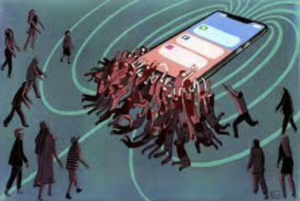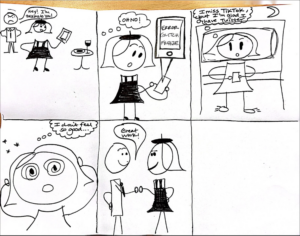Problem domain and your motivation behind it:
Our team aims to help people spend less time scrolling on their phones. Many Gen Zers struggle to put down their smartphones, especially when it comes to social media like TikTok. Endless scrolling often occurs to the detriment of college students’ sleep, homework, quality time with friends, etc. We’re designing a solution that helps people be more intentional about their phone use!

Baseline study:
To recruit participants for our baseline study, we released a screener via Google Forms searching for our target audience: Gen Z undergraduates at Stanford who were interested in reducing their smartphone use and had a screen time tracker on their smartphones. Through our pre-study interviews, we explored each participant’s past attempts to reduce smartphone use and how they spend vs wish to spend their free time. Then, for 5 days, we asked participants to send a nightly text to us reporting an activity that fulfilled them that day. At the end, we had participants send us screenshots of their screen time data from the 5 days. We concluded the study with a post-interview assessing each participants’ feelings about their screen time and what they did/didn’t like about how they spent their days. Check out this blog post to see how we synthesized our baseline study results!


Comparative Research/Analysis:
In this post, we detailed 10 major competitors in the market and their target users, discussed their strengths and weaknesses, and explained how our product would improve the experience. Here are those competitors visualized on a 2 x 2 graph of broadness vs. activeness. Ideally, our app would be passive for users but also fairly broad so it covers their different sources of screen time, making the top left quadrant our ideal square to land in. That being said, we do want to have some specificity in that we are focusing on certain times of day and want to allow users to choose apps that create the most harmful screen time for them.

This means that OneSec, ScreenZen, OffScreen, and iPhone screen time monitoring are our main competitors. Ours could improve on OneSec and ScreenZen by offering an experience that is easily configurable to all apps/websites rather than a predetermined selection. Additionally, unlike iPhone screen time, it could specify type of screen time (ie. social media) instead of evaluating users on screen time as a whole and make the screen time limit less easy to ignore. As for OffScreen, our idea can help improve the experience by providing ways for the users to choose specific apps that the screen time solution can work on and apps that the solution would not work on. We plan to distinguish our product from others on the market by making it so the screen time limiters fit seamlessly into users’ lives while creating friction that reduces screen time but also makes it less easy for users to opt out of them.
Literature Review:
Our team had three distinct takeaways from our screen time literature review (check out the articles and their summaries here:
Screen time monitoring, such as Apple’s weekly report, doesn’t reduce screen time.
Grayscale is a thoroughly studied and effective nudge for reducing screen time.
Phone use in bed and before sleep reduces sleep quality, sleep quantity, and energy levels the next day.
These takeaways informed the interventions we chose and validated our group’s target behavior in that we were drawn to similar ideas around how to reduce screen time (with nudges like grayscale) and when (at night or other high usage times).
Personas and Journey Maps along with key insights from each:


Persona 1: Artsy RJ
RJ is an organized, regimented student who wants to spend his time alone productively (painting and reading), but often spends that time on social media. RJ represents the members of our target audience who want to target periods in the afternoon where screen time interferes with other hobbies/activities.
RJ’s journey map helps inform our intervention study by showing that more social interaction is not necessarily a solution for everyone. We note here that RJ has plenty of time to be social and instead wants to redirect his screen time towards activities that he feels is more beneficial for his life. He also feels like his afternoon break isn’t long enough for painting, but his scrolling ends up lasting for a period of time equivalent to the time he would want to paint for.
Persona 2: Night Owl Nick
Nick is a student prone to procrastination whose screen time usage peaks during the night. Nick finds that it is easy to keep scrolling and easily loses track of time. He’s tried deleting apps before but always finds others to replace the ones that are gone.


Nick’s journey map narrows in on his nighttime routine and its impact on the following morning. There’s opportunity for intervention when Nick goes to brush his teeth, as this is a nightly anchor and also a moment where Nick wants to sleep but just can’t seem to feel tired. By keeping his phone away from his bed or by making it unappealing in some other way (grayscale?), we might be able to get Nick to try something else to tire him out, like reading.
Intervention/Product Ideation:
With our comparative analysis, literature review, and baseline study results, we realized that the most effective method for helping our users make reducing screen time usage a habit was through the use of “passive” methods. The main passive method that was highlighted during our analysis of the existing research literature was turning one’s phone towards grayscale. At the same time, we realized that we should also involve active intervention as well as the existing literature suggested that active interventions such as setting app limits help to produce more immediate effects.
We came up with several intervention ideas. We ultimately settled between choosing from four intervention ideas:
- Targeted Grayscale Setting
- Password Protection
- Movement Prompts
- Socialization Pledge
For our intervention study, we chose to test both intervention idea 1 and intervention idea 2 at the same time with two different pools of participants. For a detailed discussion of all four intervention ideas and why we settled on these two intervention ideas please take a look at the Discussion and Choosing an Intervention Idea section on our linked blog post.
Briefly put, we believe that both targeted phone distortion and social pressures have potential to help our users reduce problematic screen time usage. We also felt that, as long as the team could find enough participants to run both studies, then it was very beneficial to test both intervention ideas.
As far as running the intervention study, there is the main benefit of the onboarding being quite easy for our users. For those doing the grayscale study, they would set a shortcut to enable and disable grayscale on their phone and we would remind them to turn on the setting at night and to turn off the setting in the morning. For the password protection study, our participant would task a friend or family member to set a password on their app.
However, the main difficulty would be the team’s verification that our participants really acted in a way consistent with the expectations of the study. As both interventions require the participants’ active involvement, it is possible that the participant would not actually set their phone to grayscale or share a password. The main difficulty about both ideas would also be that they potentially exclude people from within our target audience of Stanford students. With grayscale, and distortion techniques more broadly, we realize that there could be issues with accessibility which would prevent people from using our app. With password protection, a person may not be comfortable with asking (or bothering depending on a user’s mindset) for someone else’s help unlocking an app or revealing a potentially embarrassing aspect of their life to another person.
Despite these difficulties, we do believe that there is significant value that can be gained through an intervention study on both of these ideas.
Intervention study:
We detail our intervention study protocol in the “Intervention Study Procedure” section of this post! For participants, we chose a mix of returners and new so that we could use our insights to target interventions for returning participants (ie. choosing the grayscale study for those who had a lot of screen time before bed) but also get fresh data. We had 6 participants for our grayscale study and 4 for our password protection one. Our results are as follows:


We gathered several key insights. Overall, the password protect study decreased screen time significantly throughout, while the grayscale study was inconclusive, as the screen time of some increased while other times decreased. For the grayscale study, we learned that certain apps feel weird to users on grayscale (Wordle, maps, facetime, etc.) so it could be good if grayscale was only specific to apps that are time-sucks. Additionally, people sometimes wanted to opt out of grayscale because it was less entertaining but most of the time they wanted to opt out because it interfered with their necessary functions on apps like the Calendar or Maps. For the password protect study, our time limit protocol had a bug because users could still ignore the time limit without asking for the passcode. However, we found that even having the reminder (+ having the icon grayed out) was helpful to reduce screen time which was a useful insight. Additionally, we found that the social pressure of asking for a password was very real, causing people to be conscious about avoiding exceeding their limit.
Storyboard & Stories –> What is the goal and role of your product in the user’s life?

In this scene we see a barista who is consistently distracted by her phone. This affects her work and has consequences for her other coworkers and boss. She downloads the app and notices something has changed on her phone. The app does not work and she switches. However, there seems to be a slight change and her head hurts from it so she stops. This ultimately causes her to get off and continue working.

In this scene we see a student who is struggling to perform her tasks due to being entranced by things on her phone. She shops to entertain herself and it ultimately sinks her grades and bank account while adversely affecting her will to do laundry. After the app though, she drops her phone and starts studying and doing laundry in place more often.
Current direction you are moving in:
As a team, we feel especially confident in the distortion idea. A key insight arose from our intervention study that people like grayscale as a way to limit their screen time but only dislike it on essential apps like the Calendar. Based on this idea, targeting grayscale and other distortion at times when users are doom scrolling would be critical. As an idea that both has a foundation in existing research and occupies a gap in the market, we believe this idea has the most potential to help users make a serious effort towards reducing their screen time usage. We plan that our final solution will involve some form of visual distortion that will discourage users from continued usage of their phone.



